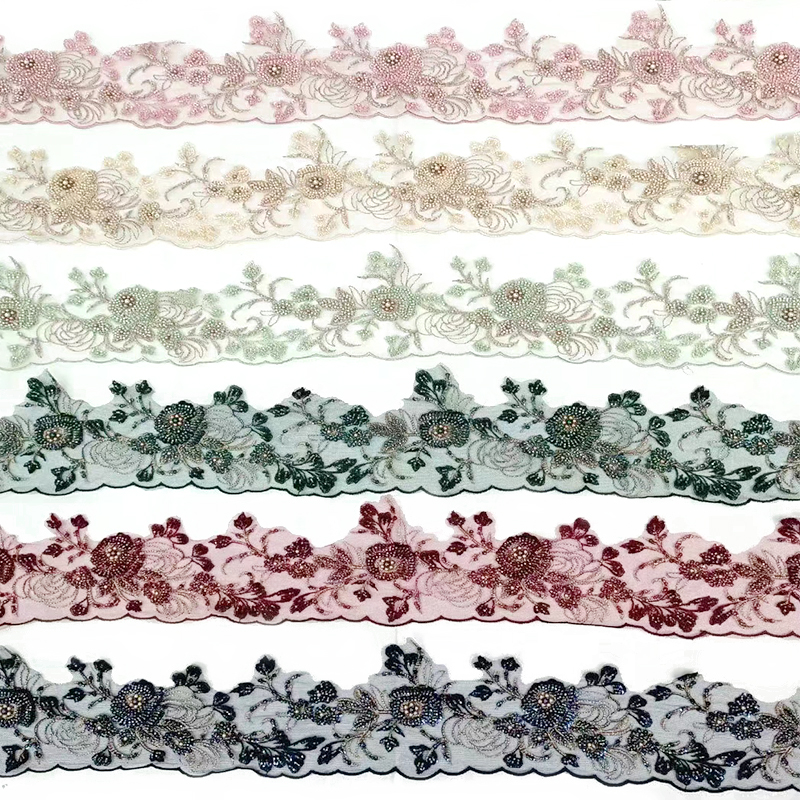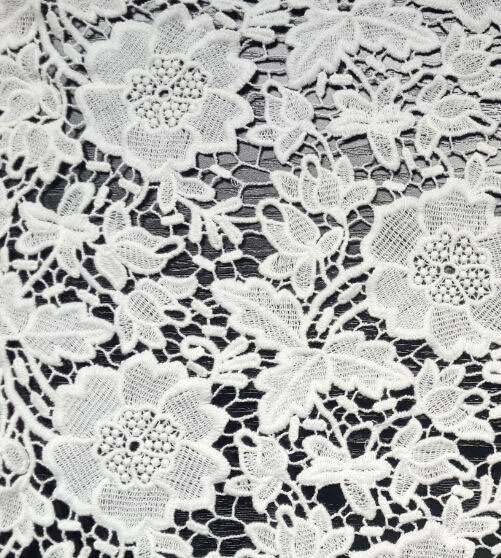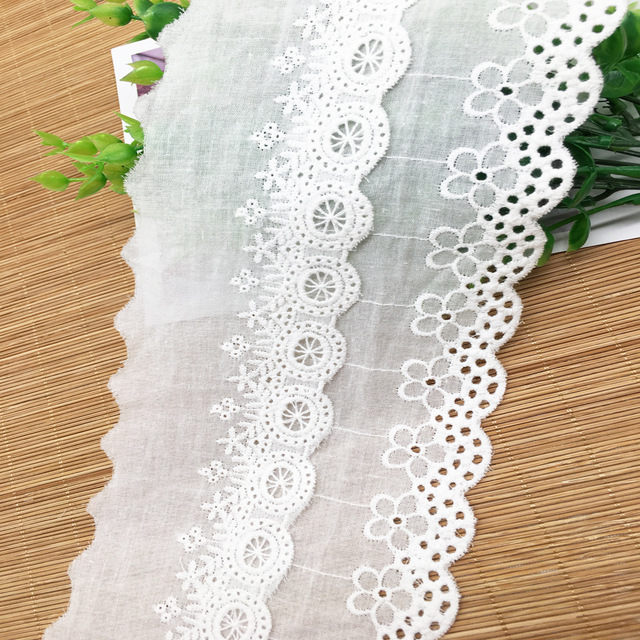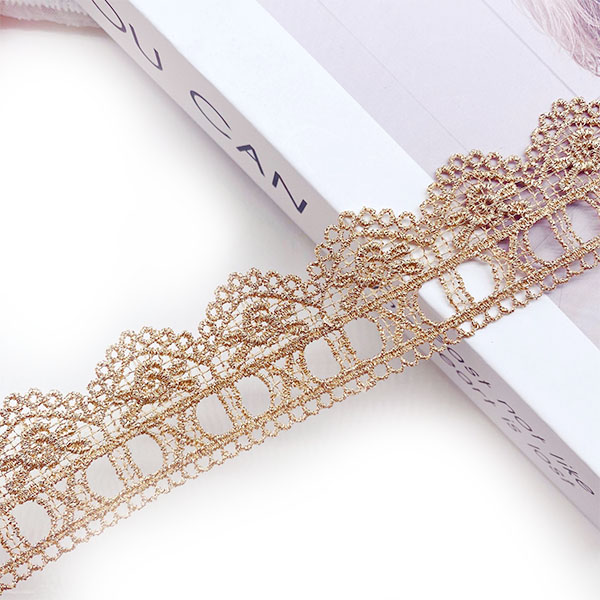Lace Ribbon Trim
Lace is a kind of embroidery, also known as "drawing". It is a decorative hollow product made of cotton thread, hemp thread, silk thread or various fabrics, embroidered or woven.
Decorative Lace Trimming
There are various patterns and patterns, used as decorative ribbon fabrics, used as moldings or borders for various clothing, curtains, tablecloths, bedspreads, lampshades, bedding, etc. Lace is divided into four categories: machine weaving, knitting, embroidery and weaving. Lace interwoven with silk yarn is widely used among ethnic minorities in our country, so it is also called ethnic lace. Most of the patterns use auspicious patterns. The woven lace has a tight texture, a three-dimensional pattern and rich colors. Knitted lace has a loose weave and prominent eyelets for a light and elegant appearance. The number of embroidery lace colors is not limited, and complex patterns can be produced. Braided lace is made by lace machine or hand-woven.


Chinese Lace
China's lace started relatively late. Before the 1980s, the machines for weaving lace were mainly imported from foreign countries. In the early 1990s, Nantong, Jiangsu absorbed the characteristics of foreign machines, combined with the actual situation in China, and independently developed my country's first A lace machine, and passed the Shenzhen Lace Factory as a pilot unit. Since then, the problem that Chinese lace machines need to be imported has ended.
Lace Classification
Stick lace, Qingzhoufu lace (divided into two kinds of mangong lace and mosaic lace), carved flat embroidery, shuttle lace, Jimo lace, hand-held lace, EMI lace, embroidery lace, braided lace, machine-woven lace... Mangong lace is made of refined cotton thread, and is woven into various fancy patterns by flat weaving, spaced weaving, sparse weaving, and dense weaving techniques, and the overall has an artistic effect of openwork. The mosaic lace is made of woven lace as the main body, and is embroidered with linen cloth. Products include plate cushions, small inserts and tablecloths, bedspreads, lace craft umbrellas, etc.
The United States is the first to appear lace. Making is a rather complicated process. Unlike traditional crochet or embroidery, books are knitted with silk thread or yarn according to the pattern effect. When making it, the silk thread needs to be passed on small shuttles one by one. Each shuttle is only the size of a thumb. A less complicated pattern requires dozens or nearly a hundred of these small shuttles, and a larger pattern requires hundreds of small shuttles. When making, put the pattern on the bottom, and use different weaving, knotting, winding and other techniques to make it according to the pattern.
Jacquard Lace
(Jacquard, Joseph Marie, 1752~1834), a French loom craftsman, the main reformer of the pattern jacquard machine. At the beginning of the 18th century, the French craftsman Bouchon created the paper-hole jacquard machine based on the principle of the ancient Chinese hand-knotted jacquard machine. He used the paper tape to drill holes to control the penetration of the thimble and replace the warp weaving points on the flower book. After being improved by Falcon, Wo Kangsong and others, it can produce 600 needles of large pattern fabrics. In 1799, Jacquard synthesized the innovative achievements of the predecessors and made a complete set of cardboard transmission mechanism, which was equipped with a more perfect pedal jacquard machine, which could weave large patterns with more than 600 needles only by one person. This jacquard machine won the bronze medal at the Paris Exhibition in 1801. Its mechanism is characterized by using a jacquard pattern board, that is, a perforated card instead of a paper tape, driving a certain sequence of thimble hooks through a transmission mechanism, and lifting the warp thread to weave a pattern according to the coordinated action of the pattern organization. After 1860, steam power was used instead of pedal transmission and it became an automatic jacquard machine. Later, it was widely spread to countries all over the world, and it was started by electric motor. To commemorate Jacquard's contribution, this jacquard machine is called Jacquard machine.

Cotton Lace Trim
Cotton lace is also called: pure cotton lace, woven lace, cotton lace, cotton lace. Cotton lace is mainly made of cotton yarn, and cotton yarn has two types: glazed and unglazed. Its specifications are as follows according to professional standards: 42 yarn counts 4 strands and 6 strands, 60 yarn counts 4 strands and 6 strands, white waxy tower wires, etc. . . Its models are S424, S426, S604, S606, and can also be recorded as 42S/4, 42S/6, 60S/4, 60S/6, where S indicates the count yarn, and the number under the slash indicates the number of strands; Different shapes can be divided into cheese and hank.
The main production machines of "disc machine" cotton lace: the current main specifications are 64 spindles, 96 spindles and 128 spindles. The working principle of the disc machine is nail weaving. It uses cotton yarn as the main raw material. The material of the disc machine is also natural yarns such as cotton, linen, wool and silk, as well as chemical fiber threads, chemical fiber threads, gold and silver threads, rayon, flower Style thread, cored thread, glitter, silver onion, ribbon rope. Cotton lace is made of high-quality cotton yarn, with high color fastness, fine workmanship, soft hand feeling, novel pattern, and various styles. It is widely used in bras, underwear, pajamas, fashion, bedding, socks, umbrellas, toys and handicrafts.
Mechanism Lace Trimming
Lace woven by various machines.
At the end of the 18th century, in the process of improving stocking looms, Europe tried to use machines to produce lace. In 1808, the British
A machine for producing mesh braids is invented and popularized two years later. In 1813, Nottingham, England invented a wooden lace loom with a jacquard device, which can produce patterned mesh braids, known as the Rivers machine, and it has been called so far. In 1846, a curtain lace loom appeared in Nottingham. Before long, machines capable of weaving various decorative lace fabrics came out. From 1900 to 1910, the machine-made lace industry in Europe was very prosperous. Machines could imitate various hand-made lace effects. Since then, machine-made lace has replaced hand-made lace. Machine-made lace can be divided into four categories according to the process: weaving, knitting, embroidery, and weaving.
① Woven lace
It is formed by interweaving warp and weft under the control of jacquard mechanism. Commonly used raw materials are cotton thread, gold and silver thread, rayon thread, polyester thread, tussah silk thread, etc. The loom can weave multiple laces at the same time, or weave them into single strips and then divide them into strips. Lace width is 3~170mm. Lace shading weaves include plain, twill, satin, honeycomb, small patterns, etc. The woven lace has a tight texture, a three-dimensional flower shape and rich colors.
② Knitted lace
In 1955, European and American countries began to produce knitted lace on multi-bar warp knitting machines. Most of the raw materials are nylon yarn, polyester yarn, etc., so it is also called knitted nylon lace. Knitted lace is loose, with obvious holes, and the shape is light and beautiful.
③Embroidery lace
It was first created in Switzerland and the Federal Republic of Germany. It controls the embroidery machine to move up, down, left, and right through the pattern board, and through the automatic exchange of the needle and the shuttle, the upper thread and the bottom thread are connected to form a pattern. Embroidery lace has fine workmanship, protruding flower shape and strong three-dimensional effect.
④ Woven lace
Woven by torque lace machine. Cotton thread is the main raw material. During weaving, the cardboard controls the twisting and moving of the spool, so that the yarns are knitted together to form a pattern. The torque lace machine can weave multiple strips of lace at the same time, and remove the connection between the laces after getting off the machine to form a single strip. The texture of woven lace is loose and airy, and the shape is smooth and beautiful.

We would love to hear from you.
408.999.9999 • info@yourbiz.com